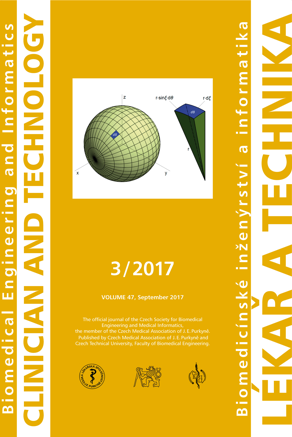METHODS FOR AUTOMATIC ESTIMATION OF THE NUMBER OF CLUSTERS FOR K-MEANS ALGORITHM USED ON EEG SIGNAL: FEASIBILITY STUDY
Keywords:
silhouette, elbow method, EEG, k-means, automatic determination of number of clustersAbstract
Lots of brain diseases are recognized by EEG recording. EEG signal has a stochastic character, this stochastic nature makes the evaluation of EEG recording complicated. Therefore we use automatic classification methods for EEG processing. This methods help the expert to find significant or physiologically important segments in the EEG recording. The k-means algorithm is a frequently used method in practice for automatic classification. The main disadvantage of the k-means algorithm is the necessary determination of the number of clusters. So far there are many methods which try to determine optimal number of clusters for k-means algorithm. The aim of this study is to test functionality of the two most frequently used methods on EEG signals, concretely the elbow and the silhouette method. In this feasibility study we compared the results of both methods on simulated data and real EEG signal. We want to prove with the help of an expert the possibility to use these functions on real EEG signal. The results show that the silhouette method applied on EEG recordings is more time-consuming than the elbow method. Neither of the methods is able to correctly recognize the number of clusters in the EEG record by expert evaluation and therefore it is not applicable to the automatic classification of EEG based on k-means algorithm.
Downloads
Published
Issue
Section
License
Copyright (c) 2017 Jan Štrobl, Marek Piorecký, Vladimír Krajča

This work is licensed under a Creative Commons Attribution 4.0 International License.
Authors who publish with this journal agree to the following terms:
- Authors retain copyright and grant the journal right of the first publication with the work simultaneously licensed under a Creative Commons Attribution License (https://creativecommons.org/licenses/by/4.0/) that allows others to share the work with an acknowledgment of the work's authorship and initial publication in CTJ.
- Authors are able to enter into separate, additional contractual arrangements for the non-exclusive distribution of the journal’s published version of the work (e.g., post it to an institutional repository or publish it in a book), with an acknowledgment of its initial publication in this journal.
- Authors are permitted and encouraged to post their work online (e.g., in institutional repositories or on their website or ResearchGate) prior to and during the submission process, as it can lead to productive exchanges.
CTJ requires that all of the content of the manuscript has been created by its respective authors or that permission to use a copyrighted material has been obtained by the authors before submitting the manuscript to CTJ. CTJ requires that authors have not used any copyrighted material illegally, as for example a picture from another journal or book, a photo, etc. It is the author’s responsibility to use only materials not violating the copyright law. When in doubt, CTJ may ask the authors to supply the pertinent permission or agreement about the use of a copyrighted material.
The opinions expressed in CTJ articles are those of authors and do not necessarily reflect the views of the publishers or the Czech Society for Biomedical Engineering and Medical Informatics.


